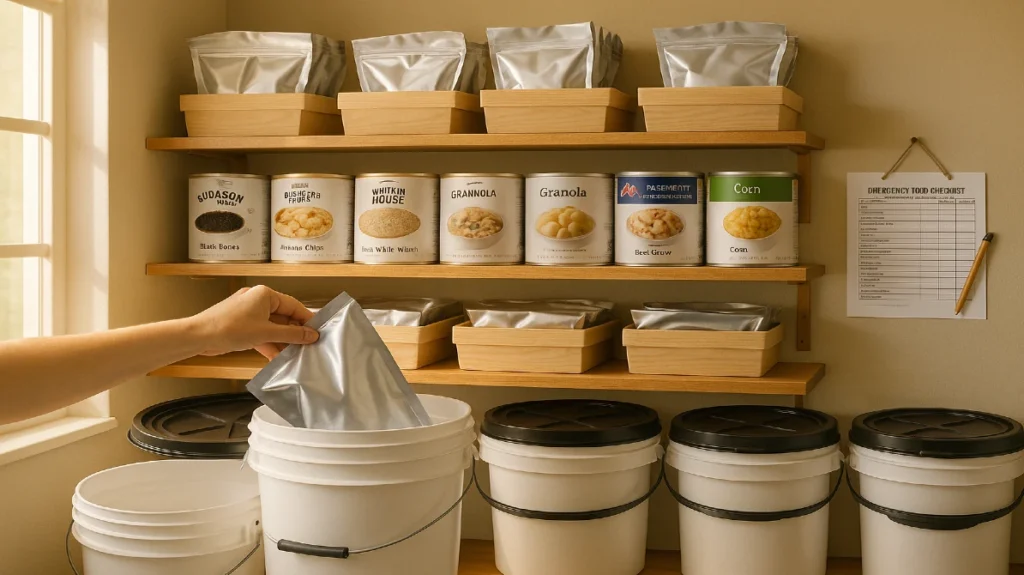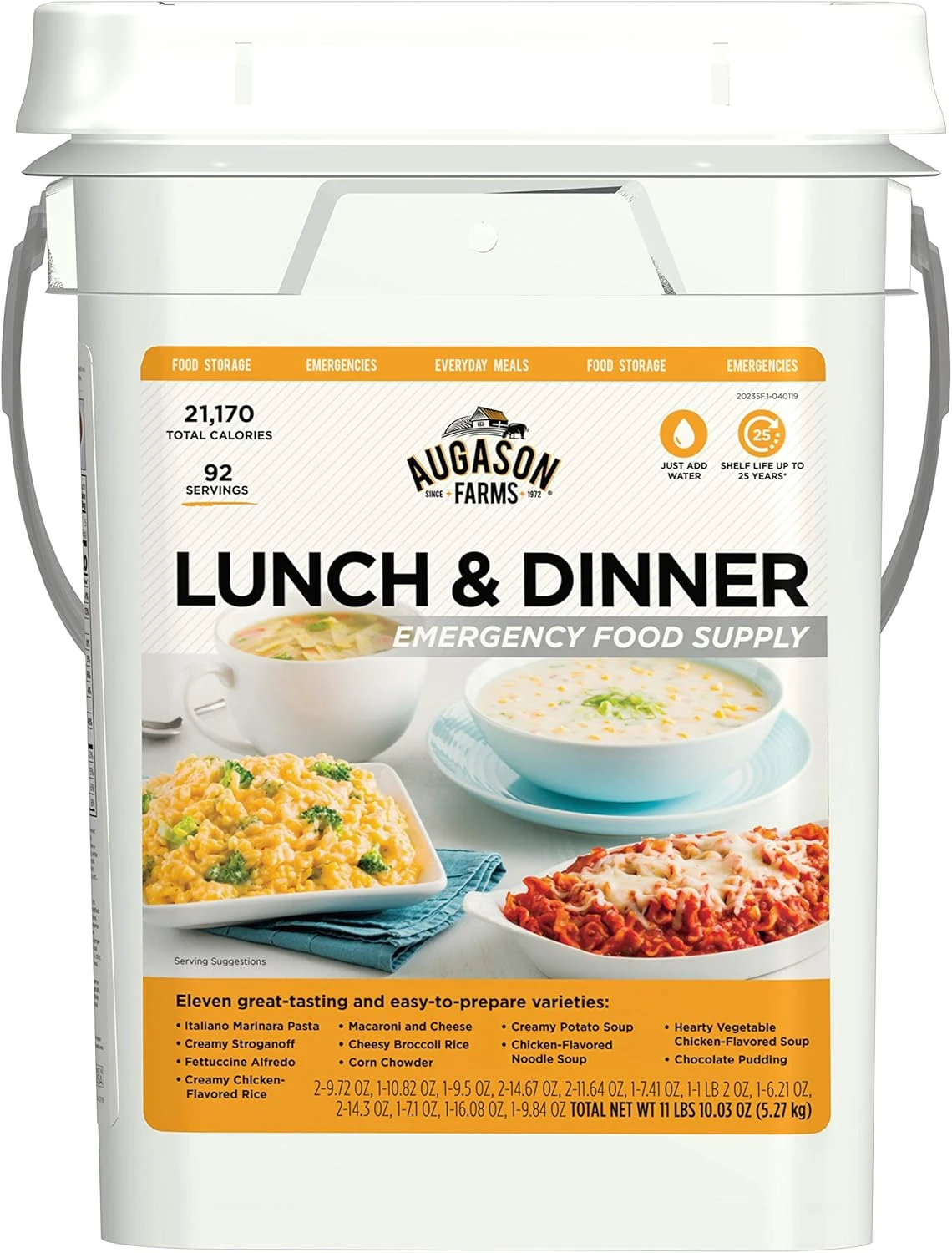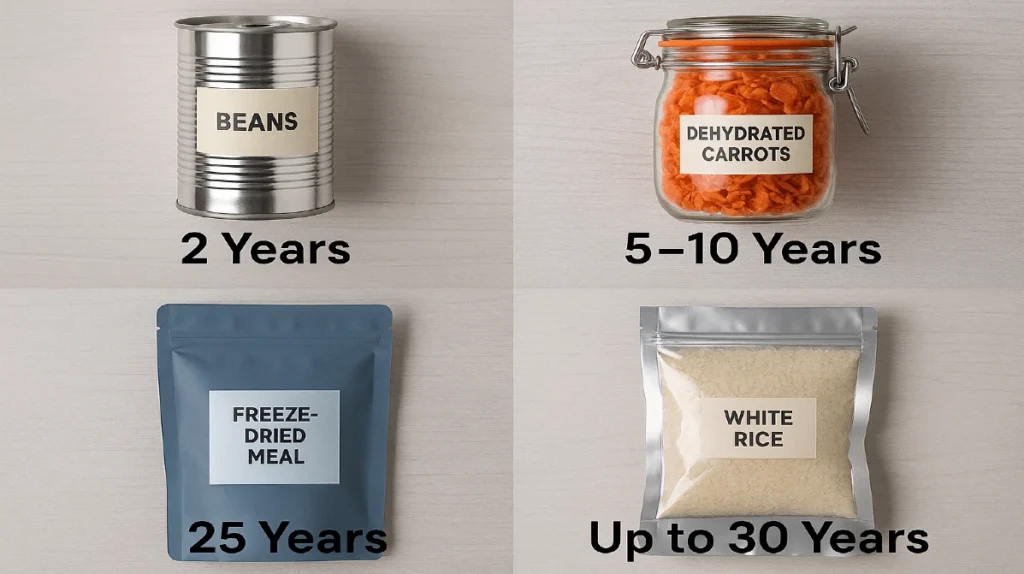
How to Build a 1-Year Emergency Food Supply
I used to think a few extra cans of soup and a bag of rice meant I was prepared. Then a weeklong power outage after a hurricane left me scrambling, feeding my kids whatever I could cobble together. That moment changed how I prepare forever.
If you’ve ever stared down a storm forecast or a sudden blackout and wondered, “Do I really have enough food to last?” this guide is for you. I’m not talking about doomsday bunkers or MREs you’d never eat. I’m talking about a practical, nourishing, storm-tested emergency food supply that your family can depend on for an entire year one shelf at a time.
Why You Should Build a Long-Term Emergency Food Supply
Emergencies don’t follow calendars. Sometimes it’s a hurricane. Sometimes it’s supply chain chaos. And sometimes, it’s just a downed power line in the middle of a heatwave. Whatever the trigger, one thing is certain: grocery stores are among the first to fail you.
That’s why more families including mine are building a true long-term emergency food supply. Not to panic. But to protect. A year’s worth of shelf-stable food means you’re no longer dependent on stores, deliveries, or luck. It means your kids eat. You stay energized. And you can think clearly in a crisis.
In this guide, I’ll walk you through every step from emergency food storage tips to picking the best emergency foods for real nutrition and long-term shelf life. I’ve made the mistakes, tested the kits, and now I’m showing you exactly what works.
Emergency Food Storage Tips That Actually Work

If you’re going to store a year’s worth of food, you’ve got to store it smart. Poor storage ruins even the best stockpile. I’ve had buckets fail from humidity, cans rust out in the wrong closet, and mice sniff out bags I thought were sealed tight. Hard lessons but you won’t have to repeat them.
- Control the climate: Store food in a cool, dry space. Aim for 50–70°F with low humidity. Avoid attics, garages, or anywhere with wild temperature swings.
- Use airtight containers: Invest in Mylar bags, oxygen absorbers, and food-grade buckets. For high-risk items like grains or flour, use vacuum sealing or dry canning.
- Elevate and rotate: Keep everything off the floor. Use shelves or pallets and always place newer food behind older items. First in, first out (FIFO) is the rule.
- Label with purpose: Every item should be dated and labeled clearly. Trust me six months from now, you won’t remember what that unlabeled white powder was.
These simple emergency food storage tips have saved me time, money, and frustration. Your food supply should work when you need it not fail you in a crisis.
Your Food Shelf Life Guide: From Weeks to 25 Years
Understanding shelf life is the difference between building a reliable supply and wasting your investment. Some foods last months. Others can keep your family fed for decades if stored correctly.
- Canned Goods: 1–5 years. Check for dents, rust, or swelling. Rotate regularly. Avoid home-canned items for long-term storage unless you’re trained in safe preservation.
- Dehydrated Foods: 5–10 years. Great for fruits, vegetables, and beans. Keep them sealed and moisture-free.
- Freeze-Dried Foods: 20–30 years. These are the gold standard for emergency storage. Light, shelf-stable, and retain nutrition better than any other method.
- Grains & Legumes: 10–25 years. White rice, rolled oats, and hard red wheat can last decades in proper containers with oxygen absorbers.
For day-to-day planning, I rely on the USDA’s FoodKeeper App a helpful tool for checking realistic timelines and spotting spoilage risks. This section is your foundation. If you get storage and shelf life wrong, nothing else matters.
Storage Solution We Recommend: Augason Farms Emergency Food Supply Kit
Whether you’re just starting your supply or adding to an existing stockpile, this kit simplifies your food storage strategy, providing great value and dependable quality.

Augason Farms Emergency Food Supply Kit
Trusted PickWhen it comes to ease, reliability, and peace of mind, I’ve consistently trusted the Augason Farms Emergency Food Supply Kit. It’s built for long-term food storage and contains nutritionally balanced meals designed for real emergencies.
Original Price: $139.99
Check Current PriceFTC Disclosure: This section contains affiliate links. If you purchase through them, we may earn a small commission at no cost to you. We only recommend products we trust and use ourselves.
Emergency Food Nutrition That Keeps You Energized

It’s not enough for your emergency food supply to just fill your stomach. When the grid is down, your stress is up and your body burns through calories fast. You need real nutrition, not just bulk carbs.
Through every hurricane I’ve lived through, the difference between feeling sluggish and staying sharp came down to what I was eating. Calories are important, but balance is what keeps you going.
What to Look For in Emergency Food Nutrition:
- Protein: Essential for muscle repair, immune function, and lasting energy. Look for shelf-stable sources like canned meats, beans, lentils, and freeze-dried eggs.
- Complex Carbohydrates: Whole grains like brown rice, oats, and quinoa provide steady fuel instead of sugar crashes.
- Healthy Fats: Peanut butter, seeds, shelf-stable oils, and nuts boost calories and support brain function.
- Micronutrients: Include canned vegetables, freeze-dried greens, and multivitamin backups. Deficiencies sneak up fast in a crisis.
The best kits including the one I recommend are formulated to hit these targets. But even if you’re building your own from scratch, always ask: Would I feel nourished eating this for three days straight? If not, fix it now before the lights go out.
Best Emergency Foods to Stock for the Long Haul
When building a year-long stockpile, variety matters. You want calories, nutrients, and comfort but you also want foods you and your family will actually eat. Here’s my tried-and-true list of the best emergency foods to include:
Top Shelf-Stable Picks:
- Grains & Carbs: White rice, rolled oats, pasta, instant potatoes, quinoa
- Proteins: Canned chicken and tuna, lentils, beans, powdered eggs, freeze-dried meat
- Fruits & Veggies: Canned tomatoes, corn, peas, dried fruits, freeze-dried greens
- Fats & Oils: Peanut butter, coconut oil, ghee, vacuum-sealed nuts and seeds
- Dairy Alternatives: Powdered milk, shelf-stable almond or oat milk
- Comfort Foods: Coffee, tea, chocolate, shelf-stable snacks, bouillon cubes
What you stock should reflect your real diet. In emergencies, stress is high and food becomes emotional. Familiar, enjoyable meals can stabilize your mindset just as much as your body.
Common Mistakes to Avoid When Building Your Emergency Food Supply
I’ve made a lot of mistakes in my early prepping days things that seemed like a good idea until I actually needed the food. So let’s save you the frustration and wasted money. Here are some of the biggest mistakes people make when building their long-term food storage and how to avoid them:
- Overloading on one type of food: I once bought a six-month supply of pasta. Guess what? You get tired of pasta. Rotate with rice, grains, and other carbs.
- Ignoring balance: A bucket of instant potatoes might be calorie-rich but it lacks protein, fat, and fiber. Build with nutrition in mind.
- Storing food in the wrong place: Basements with moisture, garages with heat, or attics with temp swings will kill your shelf life.
- Forgetting about comfort foods: Sometimes morale is half the battle. A small stash of chocolate, coffee, or your favorite tea can make hard days feel a little more normal.
- Buying things you wouldn’t normally eat: If you won’t eat it now, you won’t want it when you’re stressed. Stock foods that are familiar, nutritious, and easy to prepare.
Every item in your stockpile should earn its place. Think nutrition, versatility, shelf life and real-world usefulness.
How to Maintain and Rotate Your Emergency Food Supply
Building your supply is only step one. If you don’t manage it, you risk spoilage and waste. The good news? Maintenance doesn’t have to be hard. I’ve kept a rotating one-year stockpile going for years now and it’s easier than meal prepping for a week.
My Simple Rotation Strategy:
- Use what you store: Eat from your emergency stash weekly. Replace what you use monthly. This keeps food fresh and part of your regular diet.
- Label everything: Include the purchase date and expiration on every can, bag, or box. Use bold markers or labels you can see at a glance.
- First in, first out: When adding new supplies, push older items to the front. Train your household to follow this without overthinking it.
- Set a reminder: I schedule a “pantry check” every 90 days. It’s a 15-minute task that helps me catch expiration dates, open containers, or anything weird.
Long-term emergency food storage isn’t a one-and-done project it’s a lifestyle rhythm. Once you get into the habit, it becomes automatic. And when the next storm hits? You’ll be ready without panic shopping or guesswork.
Final Thoughts: Don’t Just Store Food Secure Peace of Mind
You don’t need to be a doomsday prepper to build a one-year emergency food supply. You just need a plan, a little storage space, and the desire to protect your family when the unexpected hits.
Storms, outages, and supply chain breakdowns are unpredictable but your food security doesn’t have to be. Whether you’re just starting out or upgrading what you’ve already built, take one step today. A stocked shelf is more than just calories it’s peace of mind in a chaotic world.
📥 Ready to start your plan? Download the free Storm-Ready Home Checklist below and begin building a food supply you can trust one meal at a time.
📄 Get the Storm-Ready Home Checklist
Frequently Asked Questions
How much food do I need for a year-long emergency supply?
Plan for around 2,000 calories per person, per day. Over 365 days, that’s about 730,000 calories per adult. Divide this across proteins, grains, fats, and fruits/vegetables for a balanced stockpile.
How long do freeze-dried foods really last?
When stored properly in sealed containers away from heat and moisture, freeze-dried foods can last 20 to 30 years. Always check manufacturer specs and store them off the ground.
Can I build a long-term supply without buying a premade kit?
Absolutely. While kits offer convenience, many preppers build their supply item by item tailored to their family’s dietary needs and preferences. Just focus on balance, rotation, and safe storage.
